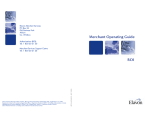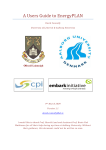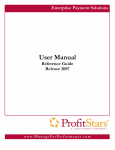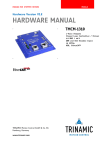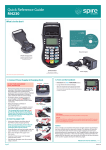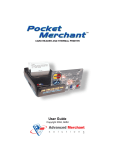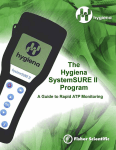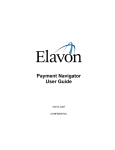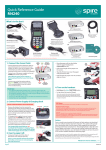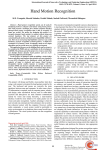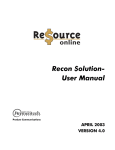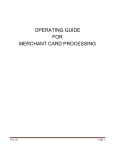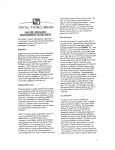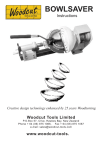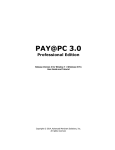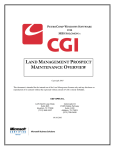Download UK Merchant Operating Guide
Transcript
Elavon Merchant Services 4th Floor, Meridien House 69-71 Clarendon Road Watford Hertfordshire WD17 1DS Merchant Operating Guide Authorisations (UK): Tel. 0845 850 0197 Merchant Services Support Centre Tel. 0845 850 0195 Elavon Financial Services Limited, 2nd Floor, Block E, Cherrywood Science & Technology Park, Loughlinstown, Co. Dublin Registered in Ireland with Companies Registration Office – Registration Number 418442. The liability of the members is limited. Regulated by the Financial Regulator, PO Box 9138, College Green, Dublin 2 – Reference Number C43558 Elavon Financial Services Limited, UK branch, 4th Floor, Meridien House, 69-71 Clarendon Road, Watford, Hertfordshire WD17 1DS. United Kingdom branch registered in England and Wales under the number BR009373 Regulated by the Financial Services Authority, 25 The North Colonnade, Canary Wharf, London E14 5HS – Reference Number 462132 Elavon Merchant Services is a trading name of Elavon Financial Services Limited REF: ELAVON MOG – UK 11/2009 UK Table of Contents Section 1 2 3 4 5 Introduction 2 Authorisation 3 Welcome Message 2.1 2.2 2.3 2.4 2.5 Automated Authorisation Service When to use Code a 10 Call Option Checking a Card Card Acceptance Cardholder Authority Electronic Processing 3.1 3.2 3.3 PAN key entry Submission of Transactions Chip and PIN Cards Statements 4.1 4.2 How to read your Statement How Card payments works 3 4 5 5 6 7 7 8 8 9 10 11 Suspicious Circumstances 12 5.3 5.4 5.5 5.6 14 15 16 16 5.1 5.2 Fraud – Card Present Transactions (Retail Merchants) Fraud – Card Not Present Transactions (Mail Order/Telephone Order/Internet Merchants) Fraud – “Code 10” How to Pick Up a Card Know Your Staff Technology Maintenance 12 13 6 Back Up Procedures – Paper Processing 17 7 Chip and PIN 18 8 9 Chargebacks 8.1 8.2 What is a Chargeback Circumstances that may result in Chargeback being raised 19 19 19 iMerchantConnect 21 10 Other Useful Information 22 11 Glossary 23 Appendix 1 – Retrieval Request Form 24 9.1 9.2 What is iMerchantConnect Key Features of iMerchant Connect Service 21 21 1 Section 1 - Introduction Welcome Message Welcome to our Merchant Operating Guide. We would like to take this opportunity to thank you for selecting Elavon as your Card payment processor and assure you that we will endeavour to provide the most efficient and professional service at all times. We want you to be totally comfortable and familiar with your Card acceptance programme to allow you to maximise its value to your business. This Merchant Operating Guide (the “Guide”) forms part of your Agreement with us. It has been designed with particular reference to point-of-sale procedures. It is important that all of your staff whom accept Card payments are familiar with the point-of-sale procedures in this Guide. We have produced this Guide, which sets out to answer the questions most frequently asked by Merchants. If you have requested a Terminal, you will also receive a terminal user manual (“Terminal User Manual”). If you have any queries not covered by either the Guide or the Terminal User Manual, please do not hesitate to contact us – our contact details can be found on the back cover of this Guide. Unless specifically defined in this Guide (including in Section 12 – ‘Glossary’), capitalised words and phrases used shall have the same meaning as set out in the Terms of Service forming part of your Agreement with us. Section 2 – Authorisation 2.1 Automated Authorisation Service Authorisation can be sought by telephoning the Authorisations centre (on the number appearing on the back cover of this Guide). Once connected you will hear the following options; FOR AUTHORISATION – Press 1 FOR CODE 10 – Press 2 Enter Merchant ID Enter Merchant ID Enter Card Number Enter Expiry Enter CVV2 (Last 3 digits on signature line on back of Card. For American Express Cards, enter the four digits printed on the face of the Card to the right hand side above the Card Number.) Enter Amount (e.g. for €/£10.00 transaction type in the pence amount also being 1000) Press 1 To Continue At this point the transaction will either be: Approved, Declined or Referred. Press 2 To Verify Details Press 1 To Verify Merchant number Press 2 To Verify Card number Press 3 To Verify Expiry Press 4 To Verify Amount Press 5 To Speak to an Agent Press 3 To Change Details Press 1 To Change Merchant number Press 2 To Change Card number Press 3 To Change Expiry Press 4 To Change Amount Press 5 To Speak to an Agent Authorisation Code: Please key this back into your Terminal, or write it in the box if using a paper voucher. 2 3 Section 2 – Authorisation Section 2 – Authorisation Declined Response: Please advise the Cardholder that the Transaction has not been authorised. An alternative payment must be sought. YOUR BANK AUTHORISED SIGNATURE Referral: Your call will automatically be transferred to an agent where they will talk you through the next steps. If a customer queries a response, please advise them that they must call their Card Issuer directly. An Authorisation Code confirms that the Card at the time of the Transaction has not been reported lost or stolen and that there are sufficient funds in the account to which the Card relates. Take Imprint of Card The Terminal may prompt you to take an imprint of the Card if the Transaction is a Card Present Transaction but the Card number is keyed rather than swiped. This may happen when the magnetic stripe on the Card cannot be read as it may be badly scratched or damaged. In such instances, please follow the procedure below: 1 Take an imprint of the Card to prove the Card was present at time of the Transaction. 2 Fill in all Transaction details. 3 Obtain the Cardholder’s signature on the imprinted voucher. 4 Retain the voucher with your daily Transaction Receipt copies. Should you need to purchase an Imprinter, please contact our Merchant Services Support Centre (on the number appearing on the back cover of this Guide). Pre-Authorisation Request: For information on how to perform a pre-authorisation please refer to your Terminal User Manual. 2.2 When to use a Code 10 call option 1 2 3 4 5 The Cardholder’s signature differs from that on the Card. The title on the Card does not match the person presenting the Card. The Card has not been signed. The signature stripe has been violated or the Card has been otherwise damaged. You have reason to be suspicious about the validity of the Card, the Transaction or the person presenting the Card. 1234 0000 1234 0000 1 Valid From 06/09 2 Card Expires 4 XXXXXXXXXX XXX John Smith 03/14 3 MR. JOHN SMITH 2.3 Checking a Card The following details must always be checked each time you accept a Card for a payment, even if the Cardholder is one of your regular customers and is known to you. 1 Start date (if available): Check that the start date on the Card is not in the future. Cards with start dates in the future must not be accepted. 2 Expiry date: Check that the expiry date on the Card has not passed. Expired Cards must not be accepted. 3 Cardholder’s name: Check that any title on the Card agrees with the person presenting it, e.g. that a Card issued to a woman is not presented by a man. 4 Signature panel: Check that the Card is signed and that the signed name agrees with the name embossed on the front of the Card. Also, check that the customer’s signature on the voucher is not written hesitantly or printed. When you are holding the Card, rub your thumb over the signature stripe, which should be smooth and flush. 2.4 Card Acceptance If you submit a Transaction from a Card bearing the logo of a Card Scheme that you are not permitted to accept, the Transaction will be rejected and returned to you. You may not process Card Not Present Transactions unless we have agreed in writing that you may do so. When carrying out a sale or Refund using your Terminal please refer to the Terminal User Manual. Hold on to the Card and the goods to be purchased and/or ensure the services are not provided, whilst you contact the Authorisations centre. 4 5 Section 2 – Authorisation Section 3 – Electronic Processing 2.5 Cardholder Authority Nothing in the Agreement, including receipt of an Authorisation Code, precludes you from the requirement to obtain authority to debit the Cardholder's account for each Transaction. Such authority shall be deemed given (unless the Card is reported lost, stolen or compromised): 1 for Card Present Transactions, by obtaining a signed Transaction Receipt or in the case of a PIN Transaction, the printed Transaction record produced by the Terminal 2 for Mail Order Transactions, by obtaining the signed written authority of the Cardholder 3 for Telephone Order Transactions by retaining documentary evidence of the Cardholder’s authority to debit his/her account for the amount of the relevant Transaction For each Mail Order/Telephone Order Transaction), you must keep and produce to Elavon on demand, documentary proof of dispatch of the goods or supply of the services rendered for not less than two (2) years from the Transaction date. 4 for Internet Transactions, by obtaining the CVV2/CVC2 number from the Card. When a Cardholder denies having authorised an executed Transaction or claims that a Transaction has not been properly executed, the Transaction Receipt or record in the case of (i) above, documentary evidence in the case of (ii) above; and the CVV2/CVC2 number in the case of (iii) above, shall be the forms by which Elavon shall endeavour to prove on your behalf that the Transaction in question was authenticated and therefore authorised by the Cardholder. Accordingly, this is the evidence that Elavon shall require from you in order to prove that a Transaction was authenticated and therefore authorised. Please note that you are not allowed to refund the cash amount when a purchase has been made with cashback. • • • • • • • • • Ensure your Terminal is set to the correct date and time. Follow the guidelines set out in Section 2.3 – ‘Checking a Card’ – of this Guide. Ensure the Transaction type identified by the Terminal is correct. Ensure the number embossed on the front of the Card matches the number printed on the Transaction Receipt. Swipe or insert the Card. Obtain Authorisation in accordance with Section 2 – ‘Authorisation’ – of this Guide. If the customer has signed the Transaction Receipt ensure the signature corresponds to that on the reverse of the Card and that all written details have copied through to the bottom copy of the Transaction Receipt. When you are confident that everything is in order, give the customer a copy of the Transaction Receipt, return the Card, and hand over any goods. Please retain the top copy of the Transaction Receipt. The Transaction is now complete. 3.1 PAN key entry If the Card is unsuccessfully swiped, the Chip cannot be read or a Terminal Card reader is not working, a message will appear on the Terminal confirming the Card has not been read successfully. If you have been provided with the PAN key entry facility, the following procedures should be followed: • The Terminal will prompt you to enter the Card details which will include: (i) Card number (PAN): the 13-19 digits Card number embossed on the front of the Card; (ii) Expiry date. • You will be prompted by the Terminal to ‘Enter’ the Transaction. An imprint of the Card should be taken on a paper voucher to prove that the Card was present and the Cardholder was asked to sign the paper voucher. Please ensure that a description of the goods, the amount and the date are also captured on the paper voucher. This will help to reduce the risk of error and therefore minimise your exposure to Chargebacks. 6 7 Section 3 – Electronic Processing The paper voucher must be kept with your copy of the Transaction Receipt. If you do not have the PAN key entry facility, the Transaction should be accepted on a paper voucher. Please refer to Section 6 – ‘Back-up Procedures – Paper Processing’ – of this Guide. 3.2 Submission of Transactions Please note that the end-of-day banking process should be carried out every day on which Transactions are accepted to avoid any late presentation charges. You should submit the data captured on your Terminal within three Business Days of the Transaction date. Any Transactions submitted after this time will be downgraded by the Card Schemes and may attract an additional charge. Section 4 – Statements 1 2 3 4 5 3.3 Chip and PIN Cards Incorrect PIN/Blocked PIN: If the Cardholder has entered the wrong PIN three times, the PIN is blocked. The Cardholder should be advised to contact their Card Issuer. The Transaction will attempt to proceed as Chip and signature via Authorisation. If this is permitted, then perform the usual checks that you would for any signature Transaction. Be extra vigilant if a blocked Card is presented. If a PIN is entered correctly but you continue to be suspicious of the Cardholder, make a Code 10 call to the Authorisations centre. Faulty Chip Cards: If the Terminal Card reader cannot read the data on the Card, the Terminal will usually prompt three times to use the Chip reader. If this is still unsuccessful after three attempts, the Terminal will default to a magnetic stripe Transaction. If this occurs then perform the usual checks that you would for any signature Transaction. 6 7 8 9 10 11 8 9 Section 4 – Statements Section 4 – Statements 4.1 How to read your Statement A merchant statement is sent to you daily, weekly or monthly in accordance with the Agreement. This shows the total of all Transaction batches by way of a Summary of Charges (“SOCs”) that we have processed on your behalf in the previous settlement period for Credit Card and Debit Card Transactions, the amount credited to your Merchant Bank Account, and the merchant service charge that is due for payment. 7 Any Transaction batch received by us that is found to be incorrect or invalid will be advised to you separately. Based on the payment summary (see point 4 below), your Merchant Bank Account will either be credited or debited, in normal circumstances, shortly after you receive your merchant statement, with the payment amount shown on your merchant statement. 9 A sample merchant statement appears on the left-hand page. Below is an explanation of some of the key information that will appear on your merchant statement. 1 2 3 BILLING PERIOD: Shows the billing period covered by the statement. PAYABLE: Shows the final amount that will be debited from your account. It also shows the last four digits of the Merchant Bank Account number from which the amount will be debited. SUMMARY: Transactions Summary – this is a summary of transactions we have settled to you by transaction type, number and amount. The Total GBP Amount is the amount we deposit to your Merchant Bank Account (see section 11 below). Fees Summary – this is a summary of fees total payable by you (as further explained in sections 4 – 8 below). 4 5 REBATES: Shows rebates made on your account during the month, for example Dynamic Currency Conversion (DCC). CARD FEES: Description – this section shows the total Merchant Service Charges Fee (MSC) payable by you by card type and volume of transactions. The base rate agreed for each card type is under the column “Discount Rate”. Any card types charged per item will be displayed under the column “Per Item Rate”. Exception Description – an exception fee is a charge that occurs for Business Card transactions and for transactions which were downgraded. Downgraded transactions are generally higher risk credit or debit transactions and include nonChip and PIN, manual keyed and non-secure internet transactions. These transactions will be listed on your Merchant Statement as Business Cards, Credit Exception, Maestro UK Debit Exception or Visa Debit Exception. 6 10 OTHER TRANSACTION FEES: Any other fees applicable to your Merchant Bank Account will appear in this section. 8 10 11 ACTIVITY FEES: This section shows fees applicable to your Merchant Bank Account for Example; Authorisations by card type (IP AUTH). OTHER FEES: Other fees such as terminal rental will be included in this section and here relevant, VAT will be charged in addition. CHARGEBACKS /REPRESENTMENTS: Any transactions still subject to chargeback or representment within the billing period are set out in this section. ADJUSTMENTS: This section details any adjustments required to be made to your Merchant Bank Account within the billing period. DEPOSITS: This section shows all transactions received (“Batch”) during the billing period which have been processed by Elavon. The “Funded Amount” is the amount that will be credited to your Merchant Bank Account. The “Payment Number” and the “Funded Amount” figure will correspond with the reference and amount that appears on your bank statement. Please note that any batch processed by other card acquirers (e. g. American Express, Diners or JCB) are not displayed here. 4.2 How Card Payments Work A Card Transaction involves the following steps: • The Cardholder is granted a line of credit by the Card Issuer. This allows the Cardholder the facility to spend up to a predetermined amount each month. American Express Charge Cards do not have a pre-set spending limit. • The Merchant or business is approved for Card acceptance and an account is opened for Card Transaction processing. When you accept a Card as a form of payment, the Transaction value is credited to your Merchant Bank Account. Details of the Transaction are then sent to the Cardholder’s Issuer, where the amount is debited from his/her account. This transfer of funds normally occurs within three Business Days and will be listed in the statement of both parties – a credit appears on your merchant statement and a corresponding debit on the Cardholder’s account statement. Transaction flow: The Transaction and the transfer of value flow from your Terminal to an Acquirer, to the Cardholder’s Issuer and finally to the Cardholder’s account. Acquirers receive payment in the opposite direction and transfer the value to your Merchant Bank Account. During this process the Transaction has travelled through Visa, MasterCard, or American Express processing networks, which cover the entire world. This entire procedure is called 11 Section 5 – Suspicious Transactions “Settlement”. Our merchant service charge is deducted from your submitted Transaction batches, along with any other adjustments, such as corrections or Chargebacks. 5.1 Fraud – Card Present Transactions (Retail Merchants) Your business has been approved to accept face-to-face Transactions where the Card is present at the time of the Transaction. Here are some tips to help you protect your business against fraud – • If you have a Terminal, advise all your staff that a manual imprint must be taken for Cards where the Terminal cannot read the magnetic stripe/chip. The customer must sign the imprinted voucher and Authorisation must be obtained. Should you need to purchase an Imprinter, please contact our Merchant Services Support Centre. • Do not process Card Not Present Transactions. Check the details on the Card: Check that the expiry date on the Card has not passed, and also check that • • • the start date (if available) is not in the future. Check the Cardholder’s name – make sure the title agrees with the person presenting the Card (e.g. that a Card issued to a woman is not presented by man). Check to make sure the Card is signed and that the name is the same as that embossed on the front of the Card. Check that the Card has a magnetic stripe and that the Credit Card logo is shown on the Card e.g. MasterCard, Visa, American Express and that the hologram (if present) moves/changes. For American Express Cards, make sure that there are four digits printed on the front of the Card to the right-hand side above the Card number. Ensure that this number cannot be rubbed off. Check the signature on the receipt matches the signature on the Card (if the Card is not a Chip Card). Check the Card details imprinted on the Transaction Receipt match what is imprinted on front of the Card. Please refer to Section 5.3 – ‘Fraud – Code 10’ – of this Guide for reasons to be suspicious. Section 5 – Suspicious Transactions Your customer is then prompted to enter their 4-digit PIN into the PIN Pad. • A customer must never disclose their PIN to you, and you should always look away whilst the PIN is being entered. There are various PIN Pad designs with additional shielding around them but always encourage the customer to shield the PIN Pad when entering the PIN. Other customers in the queue should also be encouraged to be mindful of those entering their PIN and must stand away from the till point. • When presented with a Chip Card, always use PIN verification rather than a signature. Please note that Chargebacks will become your responsibility if a PIN is not used. Carefully follow the instructions given by the Terminal, therefore, should the customer request not to enter the PIN. OVERALL CARD ACCEPTANCE GUIDE • • • • • Only process a Refund on the Card on which the original Transaction took place. DO NOT refund a Card where the original payment was by other means e.g. cash or cheque. DO NOT split a sale into smaller amounts. Check the expiry date is valid. The Card must not be accepted if it falls after this date. DO NOT process Transactions for any other business than your own. DO NOT process any Transactions on a Card issued in your name or of a director or partner of the business. 5.2 Fraud – Card Not Present Transactions (Mail Order/Telephone Order/Internet Merchants) Before accepting any Card Not Present Transactions, please ensure your Agreement allows you to do so. You must take the necessary precautions to safeguard such Transactions and help reduce the risk of a Chargeback arising. Most losses are generally experienced by a Merchant as a result of Card Not Present Transactions. Mail Order/Telephone Order Transactions are high risk, and a merchant retains all liability should a Transaction prove to be fraudulent or not authorised by a Cardholder. Watch out for… Chip Cards ACCEPTING A CHIP CARD Either your Terminal or Terminal User Manual will advise whether you or your customer inserts the Card into the Terminal. 12 13 Section 5 – Suspicious Transactions • • • • • • • Multiple Transactions from the same Card number. Multiple Transactions from the same country, i.e. multiple Transactions where all the Card numbers begin with the same six digits. It is the same four digits in the case of American Express Cards. Multiple use of the same Card number in a short time span. Multiple Transactions from the same address or area. Sharp increase in turnover /sales requests. High volumes of goods which are easily re-sold e.g. televisions, DVDs, hi-fi systems, computers. Transactions/orders from other countries which may appear unusual. Tips to help prevent fraudulent transactions… • • • • Verify the address for high-value Transactions – only forward goods to the billing address. Take a telephone number, address and check details against an electronic register or telephone directory. Get the customer to provide the 3-digit code listed after the Credit Card number on the reverse of the Card. For American Express Cards, request the customer to provide the four digits printed on the face of the Card to the right-hand side above the Card Number. You will need this information if you are suspicious of the Transaction. Goods should never be given to taxi drivers, couriers or chauffeurs at the request of Cardholders. Goods should be delivered to the Cardholder’s address. Care should be taken if delivering to a different address other that the Cardholder’s billing address. IF A CARDHOLDER ASKS TO PICK UP THE GOODS, PLEASE TREAT THIS AS A CARD PRESENT TRANSACTION RATHER THAN A CARD NOT PRESENT TRANSACTION. 5.3 Fraud – ‘Code 10’ Responsibility for any fraudulent Transactions lies with the merchant. The Code 10 procedure is designed to help reduce the use of fraudulent Cards. Authorisation does not guarantee payment, however, there are many reasons that can prompt you to be suspicious and take steps to avoid being a target of fraud such as: • • • 14 Section 5 – Suspicious Transactions • • • • • A customer appears disinterested in price or precise description of the goods. A customer appears nervous and in a hurry. A customer suggests splitting a sale into two or more separate sales. A customer appears to be quoting someone else’s Card details e.g. a male presenting a female’s Card details. A customer is trying to distract you. For further information on the above, please contact our Merchant Services Support Centre. If you are suspicious of any Transaction regardless of whether the Transaction is Card Present or Card Not Present, you should make a ‘Code 10’ call to the Authorisations centre. 5.4 How to Pick Up a Card • • In some circumstances Card Issuers may request the return of a Card. If so, the Terminal may display a message saying ‘RETAIN CARD’. Alternatively, a Merchant may call the Authorisations centre when instructed by the Terminal and the agent may advise that the Card must be retained and returned to the Issuer. The Authorisations centre will issue you with a reference number. If this happens, do the following: 1. Advise the customer that their bank requests that the Card be retained and returned to them. If the Cardholder has any questions, he/she should contact their bank directly. 2. You will be issued with a pick-up reference number from the Authorisations centre agent. Note: Please cut off the bottom right-hand corner of the Card taking care not to destroy the embossed Card number or magnetic stripe. This should be done discreetly and not in front of the customer. Note: Rewards will only be payable when a retain Card request has been issued either by the Terminal or by an Authorisations centre agent. Please attach the Terminal receipt which states retain Card or include retain Card Authorisation Code which is given over the telephone by the Authorisations centre agent. A customer is hesitant when signing the paper voucher. A customer provides you with a second Card in a different name. A customer provides more than one Card number to cover one order or set of orders. 15 Section 5 – Suspicious Transactions Please return both parts of the Card together with a note detailing the reference number received, your Merchant ID, the name and telephone number of the person responsible for recovering the Card to: Card Recovery Section, Financial Control Group (CPE), PO Box 56, IDA Business Park, Arklow, Co. Wicklow, Ireland Please note that you are not expected to endanger your own safety or that of other members of staff when retaining a Card If the Cardholder is not present when you are advised to retain their Card, please advise him/her to contact their bank, as you are unable to authorise the Transaction. 5.5 Know Your Staff • • • • Obtain and check references for all staff hired including temporary and short term cover. Ensure accurate staff records are maintained and individual employee IDs are provided. Ensure full training is given to all staff on accepting Card payments. Complete audit checks from time to time to ensure that correct procedures are being adhered to, e.g. employees are using their individual IDs and not those of fellow employees. 5.6 Technology Maintenance • • • • 16 Ensure all Terminal device wiring is secure and not accessible to the public/unauthorised members of staff. Ensure regular checks are made to monitor that no additional recording or key capture devices are present on the site, e.g. in ceiling panels attached to laptops or charity boxes. Ensure surfaces around the till area are clear so that any unauthorised attachments/recording devices can be easily identified, including mobile phones. Complete regular checks on all equipment to ensure that no tampering has taken place. Section 6 – Back Up Procedures - Paper Processing If your Terminal ceases to work, please follow the manual procedures set out below. Please note, this form of Card processing should only be used as a backup if your Terminal is not working. Manual Sale: There are no floor limits for manual sales so you must contact the Authorisations centre for all manual sales and obtain an Authorisation Code before continuing with the Transaction. Please refer to Section 2 – ‘Authorisation’ – of this Guide. Should you need to purchase an Imprinter, please contact our Merchant Services Support Centre. 5 4 1 1 2 3 4 5 2 3 Sales Voucher Refund Voucher can be filled out in the same way Cardholder’s signature. Complete when authorisation is obtained. Total value of Card transaction. Details of goods/services purchased. Transaction date. Manual Sale Procedure (Card Present): • Request Cardholder’s Card. • Contact Authorisations centre for Approval. • Insert the Card face up in the Imprinter and insert the paper voucher for either sale or Refund, above the Card. • Operate the Imprinter by sliding it firmly from left to right and back again to the starting position. • Remove the paper voucher and check that all copies have been imprinted clearly with the full Card details and Merchant information. • Remove Card from Imprinter. • Complete the paper voucher using a ballpoint pen. The Authorisation Code received from the Authorisations centre must be entered on the paper voucher. • Retain the Card and watch the Cardholder sign the paper voucher. Check that the signature is the same as that on the reverse of the Card. • Check again that the details are correctly entered and appear on all copies of the paper voucher. If they do not, destroy the paper voucher and start again. • When you are satisfied that everything is in order, give the Cardholder the top copy of the paper voucher and return the Card. • Retain the remaining copies of the paper voucher in a secure place until you can process it electronically through your Terminal. • Once the Terminal becomes available, please re-enter the Transaction using the force or offline procedure. Please refer to your Terminal User Manual for details. Any paper vouchers should be submitted to us for processing within 3 Business Days. 17 Section 7 – Chip and PIN 8.1 Chargebacks YOUR BANK 1234 0000 1234 0000 Valid From 06/09 Section 8 – Chargebacks Card Expires 03/14 MR. JOHN SMITH Credit and Debit Cards are changing from signature-based magnetic stripes to PINbased Chip Cards. This initiative, which is known as “Chip and PIN”, is in response to escalating levels of fraud, most notably, counterfeiting and the use of lost or stolen Cards. A Chip Card contains a microchip, which is embedded into the Card. It contains extremely secure memory and processing capabilities. The information it contains helps ensure that the Card is authentic and makes it difficult and expensive for a criminal to counterfeit the Card. A PIN is entered by the Cardholder to confirm that they are the actual owner of that Card. The introduction of PIN removes the need for the Cardholder to a sign a paper Transaction Receipt. A Chargeback may occur for any of the reasons set out in Section 8.2 – ‘Circumstances that may result in a Chargeback being raised’ – of this Guide and for any of the reasons listed in the Terms of Service which form part of your Agreement with us. Also, a Chargeback may occur when an Issuer returns unpaid a Transaction to a Merchant if they consider the Transaction to be invalid or unauthorised by the actual Cardholder. A Chargeback will be raised by the Issuer against the Merchant as soon as the Issuer is made aware of a suspicious Transaction. However, the time period for raising a Chargeback can be as much as 180 days from the Transaction date. IMPORTANT: The Merchant will be liable for a Chargeback if any paper voucher used does not bear an Authorisation Code and/or if the value on the paper voucher is above the floor limit. Floor limits are dictated by the International Card Associations and American Express. Any Chargeback queries should be addressed to the Chargeback Department. 8.2 Circumstances that may result in a Chargeback being raised • • • • • • 18 Split sale – If the Merchant splits a high-value sale into two or more amounts that are below the floor limit to force the Transaction through without checking for Authorisation on one high-value Transaction amount. If the Merchant’s Terminal requested that the Merchant call for Authorisation but the Transaction is forced through without calling the Authorisations centre. Alternatively if the call is made but Authorisation is Declined and the Transaction is still forced through. The amount processed by the Merchant exceeds that authorised by the Cardholder. Duplication – If a Transaction is put through twice in error. Expired Card – If the Merchant puts through a Transaction on an expired Card. No Transaction Receipt – If the Cardholder’s Issuer requests a copy of the paper voucher and the Merchant is unable to provide sufficient signed/imprinted documentation to prove the Cardholder actually participated in the Transaction. Paper vouchers/Transaction Receipt copies must be kept by a Merchant for at least 18 months from the Transaction date. 19 Section 8 – Chargebacks • • • • • • • • • • • • • • 20 If the Merchant cannot provide written evidence of a Transaction taking place within the time limits set by the Card. Refund not processed – If the Cardholder has written evidence that the Merchant agreed to process a Refund but has not received the Refund. Failing to take an imprint of the Card at the time of the Transaction or failing to get the Cardholder to sign a paper voucher. Late presentation – If a Transaction is processed by the Merchant beyond the three Business Days time limit. A Card account number was incorrectly manually entered into the Terminal or handwritten on a paper voucher causing the Transaction to be processed to an invalid/incorrect Card account. Cancelled recurring Transaction – If a Cardholder has written evidence that they have cancelled a mandate/subscription with the Merchant but the recurring Transactions are still being processed to his/her account. Credit posted as purchase – If the Merchant puts through a Refund but it is processed as a sale, therefore debiting the Cardholder account again. This Chargeback is for twice the Transaction amount. Goods not as described – If the Cardholder has a picture or written description of an item that they have ordered by mail/telephone but the Merchant has sent an item where the colour, size, quality, etc. of that item differs from the original description. Non-receipt of merchandise – If a Cardholder orders goods by mail/telephone but they do not receive the item within 30 days after the agreed date for receipt. Services not rendered – If the Cardholder has paid for a service and the Merchant is unwilling/unable to provide that service. Incorrect currency – If the Cardholder signs a paper voucher for one currency but the Transaction is processed in another currency to his/her account. Accepting a Card with a violated or tampered signature stripe. Any Card Not Present Transaction. Failure to respond to a Retrieval Request (copy attached at Appendix 1) Section 9 – iMerchantConnect 9.1 iMerchantConnect (www.iMerchantConnect.com) iMerchantConnect is an innovative online service offering you the opportunity to view your accounts online wherever and whenever you choose. 9.2 Key Features of iMerchantConnect Service Account Information • • • • • • View date funds were last transferred to your account. View Retrieval Requests and Chargebacks. View your business profile. Information on troubleshooting and compliance issues. Restrict users to certain Merchant numbers or groups of Merchant numbers on a log-in basis. See your merchant service charges for the previous month’s statement. Review Sales • • • • • • • • See your sales turnover by Card type for the current month. Confirm deposits. View batches and Transactions. View monthly statements for the previous 12 months. Analyse your turnover for the previous 12 months. Multiple-outlet Merchants will appreciate the roll-up functions that allow them to see an aggregated view of their entire business. Reconciliations are made easier using the online Transaction screens. Account information available at your fingertips – no more calls to individual sites trying to trace Transaction information. 21 Section 10 – Other Useful Information Retention of Documentation: You must retain, in a safe and secure place, copies of your sales and Refund Transaction Receipts and also summary vouchers used, for at least 2 years, in case there is any dispute regarding a Card Transaction. The Issuer may ask you to supply documentation for a particular Card transaction. This must usually be provided within 14 Business Days of the request, either in its original form or as a copy. In some exceptional circumstances, e.g. Card fraud, the Issuer will ask you to supply the documentation within 48 hours of the request. You must supply the documentation within this time when requested to do so. When destroying documentation after 2 years, be sure to do so in a secure manner. Advertising / Point of Sale Display: If you wish to advertise in the press or other media to show that you accept Cards as a method of payment, the following rules apply: • The Card Scheme logos have been registered as trademarks and must be used in accordance with instructions issued and available from the Card Schemes. If you wish to obtain further details regarding advertisements, please contact our Merchant Services Support Centre. • The Card Scheme logos must not be featured in advertising in a manner where endorsement of the goods and/or services being offered by you, is given or implied. • Card decals/stickers are provided to all retailers. These must be clearly displayed in your outlet(s). Once displayed, you cannot refuse to accept a Card Transaction. Section 11 – Glossary Section 12 – Glossary Acquirer: A financial institution which processes Card transactions accepted at the Merchant’s premises as payment for goods and/or services. Approval: When a Transaction is approved it means that there are enough funds in the account and that the Card has not been reported lost/stolen at the time of the Transaction. Therefore, you must take additional steps to ensure the Transaction is genuine. Remember an Authorisation Code/Approval does NOT guarantee payment. Please refer to your Fraud Manual for further details. Chip: A microchip that is embedded in a Card that contains Cardholder data in an encrypted format. Code 10: Code 10 is a recognised code which has been designed to warn Authorisations centres when Merchants are dealing with suspicious Transactions. Declined: Change of Bank Account Details: When you get a declined response from the Authorisations centre or electronically through the Terminal this means that the Issuer cannot authorise that Transaction. In this case, the Cardholder will need to contact their Issuer to find out why, and use an alternative method of payment. Change of Ownership/Status/Name/Address: Imprinter: If you change your nominated bank account, as defined in the Terms of Service, you must complete and return a new Direct Debit Mandate form. If your business (or any of its outlets) changes ownership, status, products sold and/or services supplied, name or address, you should immediately inform our Merchant Services Support Centre and follow their instructions. A machine which takes an imprint of the Cardholder’s Card onto a paper voucher. Broken or Faulty Imprinters: A service which may be provided at a Terminal where Card details embossed on a Card are keyed into the Terminal instead of the Terminal reading the Card’s magnetic stripe. If you have any problems with broken or faulty Imprinters, contact our Merchant Services Support Centre. PAN key entry: What to do if a Card is left at your premises: Contact the Issuer immediately for further instructions. The telephone number is to be found on the back of the Card. 22 23 Section 11 – Glossary Appendix 1 – Retrieval Request Form Referral: Routine security check on a Card, where response comes from the Issuer. In this case you will need to contact the Authorisations centre to obtain Approval. Chargeback Department PF 710 247 60492 Frankfurt Phone: 848 800 984 Fax: 0049 6951 709513 Refund: The process by which funds are returned to a Cardholder’s account following the return of goods. Retrieval Request: means a request initiated by a Cardholder or Issuer that requires you to produce a legible copy of a Cardholder’s signed Transaction Receipt (except in the case of properly effected PIN Transactions or certain other Card Not Present Transactions such as a Telephone Order Transaction that requires signature on receipt) within a specified period of time, and/or any representment request by an Issuer requiring you to represent the Transaction Receipt for a Transaction. A. MERCHANT 123 High Street London E12 21.11.2009 Respond By: 10.12.2009 Case Number: 1012345678 Retrieval Request For prompt service, please return this cover letter with your rebuttal Following is a credit card charge from your business. Please locate the item and return it immediately via email at the above address or fax it to 0049 6951 709513. Merchant Name: Reference Number: Merchant number: Cardholder Account #: Retrieval Amount: Acquirer Reference #: Transaction Date: Transaction ID: Outlet Reference Number: Batch Reference Number: Original Transaction Amount: Terminal/Till ID: Ticket #: Why card issuer is Requesting Copy: 29-Facsimile Draft IMPORTANT REMINDER: Please attach a legible copy of the white portion of the sales receipt to this form, and return it to the Chargeback Department immediately upon receipt of this request. If faxing, please send a clear and legible copy of the original sales receipt. To verify receipt or legibility of your response, please allow seventy-two hours before calling for status. Card Association regulations state that if an issuer initiates a non-receipt chargeback, the chargeback will be charged to your account, and cannot be reversed. It is extremely important that you respond immediately to meet all Card Association regulations. Items ruled illegible by the Card Associations are also subject to chargeback and association fees. Address/Fax number changes should be sent to the address/fax number above. Elavon Financial Services Limited Registered in Ireland – Number 418442 Registered Office: Block E, 1st Floor, Cherrywood Business Park, Loughlinstown, Co. Dublin, Ireland Directors: Robert Abele (USA), John Collins, Terrance Dolan (USA), Pamela Joseph (USA), Declan Lynch, John McNally, Malcolm Towlson Elavon Financial Services Limited, trading as Elavon Merchant Services, is regulated by the Financial Regulator 24 25














